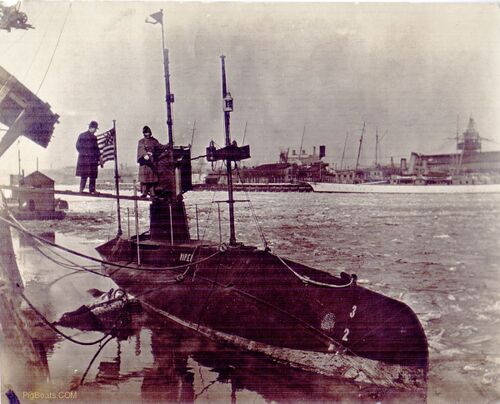B-1

In this photo only a number of things are known for certain the rest can only be speculated on. The USS Viper (B-1) was commissioned October 18, 1907 with Lieutenant Donald Cameron Bingham in command. On November 17, 1911 her name was changed from Viper to B-1. The submarine has the name Viper clearly painted on the hull. From the pigstick atop her periscope is the vessels Commissioning Pennant along with another flag, probably a squadron flag. These are the time frames that bracket this photo. To narrow it down still further, it is winter and cold enough to have the river or bay awash with hundreds of thousands, if not millions, of chunks of ice covering its surface.
So we can also assume it is either winter 1907/08, (winter 1908/09 she has been placed in reserve and out of commission at Charleston). Recommissioned April 15, 1910, winter 1909/10 and winter 1910/11 are also time frames this image could have been snapped.
Submarine historian David Johnston thinks that the photo was taken at or near the Brooklyn (New York) Navy Yard just prior to a dry dock period that all three B-boats had in January, 1908. If it was after dry docking the waterline would appear cleaner and crisper.
The submarine has much of the look of the paint jobs given to the vessels around the time of their commissioning with darker colors, (black), and a light, (white), boot-top. On the foremast are the submarines red and green running lights attached to their reflector boards. These boards are to limit the direction that the lights can be seen from. Above them, is the anchor light higher on the mast. This is a white light and used when at anchor to note it position to other vessels. All these lights and the mast, are portable and are removed and sent below when the submarine is going to dive. Stanchions and a lifeline surround the small walking deck that submarine inventor John Holland so detested, ("...for officers to strut on...", he said). These, too, were sent below when diving

The Viper is moored to a high pier, that is evident by the boarding plank stretched between the pier and the top of the bridge access fairwater. A civilian is standing midspan talking with an officer, (Captain Bingham?), about something. The civilian looks to be carrying a briefcase of some sort in his left hand. The officer is gesturing towards the camera and down about something, maybe in the water. The officer is wearing a wool Naval Academy Great Coat and white, (wool?), gloves. Seen just behind the officers legs is the tall Engine Room ventilator.
The top of the bridge is surrounded by weather cloths to protect the crew, (duty officer and helmsman), from spray and wind. Just forward of these cloths is ventilator used to bring or exhaust air from inside the submarine. Its opening is pointing to the subs port side. These, along with all the above mentioned items, are also sent below before diving. Pressure of moving though the water would restrict the vessels movements, reduce its speed and probably destroy canvases.
There appears to be a fairly stiff wind blowing by the looks of all the flags and that wind seems to be coming from the subs after port quarter. The flag is a thirteen star Naval Ensign. As related by flag historian Jeff Bridgman..."It wasn't until 1916, however, that President Woodrow Wilson wrote an executive order that terminated their use entirely in favor of 48 star flags. But even this did not completely put an end to it. According to at least one flag historian, Wilson's order was not immediately accepted on all navy ships. Old habits die hard..." The flag being flown seems to be of an older design that was flown between 1890 and 1900 with the rows of 3 stars with points pointing up and the rows with two stars with the points pointing down.
The wind chill factor must make the temperatures must feel like they are in the upper 20's down into the teens or lower.

In the left background, under the gangway and just sticking out from behind the floating shack, is the bow of another "B" class submarine. Draft makings like the ones on the bow of the Viper resemble each other. Its periscope can be seen sticking up at the left edge of the shack with a pennant flying from its top. Identity unknown at this time. Thanks to submarine historian David Johnston for pointing out this important piece of information for us.

We have another clue but the identity of that clue is unknown, at this point, that is the sleek steam yacht, with its raked masts and funnel, seen in the background. If we knew what vessel this was and where it was at we could pin down the year/s and location with more certainty. Further evidence is the presence of the large 100 ton derrick seen over the top everything at the right side in the background of the photo that resided at the New York Navy Yard and is in evidence in other photos taken at this location and time period.